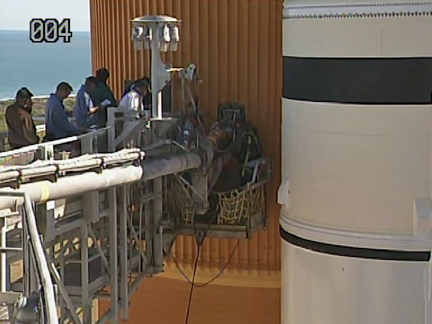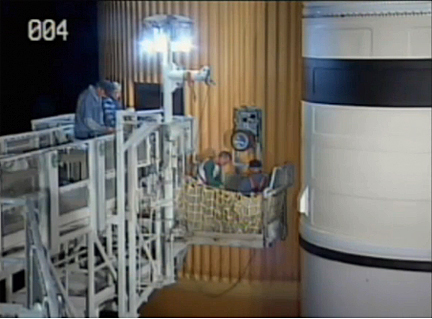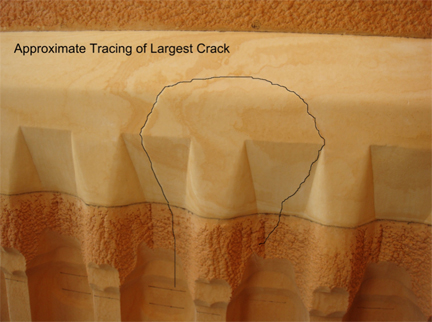Engineers begin disassembly of leaky shuttle vent line fitting
Editor's note...
CBS News
KENNEDY SPACE CENTER, FL--Engineers disconnected a 7-inch hydrogen vent line from a leaky quick-disconnect fitting on the side of the shuttle Discovery's external tank Tuesday that grounded the ship last Friday. Disassembly of the suspect fitting was expected overnight, with troubleshooters taking in situ photographs of the hardware, double-checking its alignment and looking for any obvious signs of trouble.
A detailed laboratory analysis of the quick-disconnect components is planned, but the fitting will not be re-attached. Instead, engineers plan to install replacement hardware by the end of the week that has a leak-free performance history.
Discovery's space station resupply flight is on hold until at least Nov. 30, the opening of the year's final shuttle launch window, while engineers work to resolve the leak, repair a large crack in the external tank's foam insulation and replace a circuit breaker that may have contributed to a subtle electrical glitch earlier last week.
Engineers also may carry out a fueling test, pumping supercold rocket fuel into Discovery's tank to make sure the replacement hardware is leak free, before pressing ahead with another round of launch preparations. But no final decisions have been made.
In any case, engineers say the foam crack may be the more significant challenge facing the launch team. It is not yet clear whether the damage is limited to the foam or whether the visible crack was caused by a defect of some sort in an underlying structural component. Repair plans are being developed to cover both scenarios.
Past leaks in the ground umbilical carrier plate, or GUCP, that connects a 7-inch hydrogen vent line to the side of the shuttle's external tank were blamed on temperature-induced trouble with internal seals, mechanical alignment of the hardware or both.
Extensive corrective actions were taken in the wake of two mission delays in 2009 and the system worked normally until Discovery's fueling Friday, a period covering 12 successful fuelings with six different tanks.
The vent line is used to carry excess hydrogen gas away from the shuttle as the tank is filled with super-cold propellant. During fueling, a valve is opened periodically to route hydrogen to the vent line as required to maintain the proper pressure in the tank. The excess gas is carried to a nearby "flare stack" where it is burned off. Just before launch, the vent valve is closed and the tank is pressurized for flight.
The vent line attaches to a port on the side of the external tank. At launch, an explosive charge fires, the quick-disconnect fitting separates and counterweights quickly pull the vent line down and out of the way.
During Discovery's fueling, sensors near the GUCP detected a major hydrogen leak about an hour after the three-hour tanking procedure began, well before the point where the earlier leaks showed up. Free hydrogen concentrations were above 6 percent, the limit of the sensors' ability to record, and the countdown was called off.
The vent line attachment fitting met specifications and passed pre-fueling tests, using helium at room temperature as a stand in for gaseous hydrogen. Because of the size of the leak, some engineers believe they will see an obvious defect when the hardware is taken apart and examined. Others are not so sure.
In parallel with the GUCP repair work, engineers are developing plans to repair a long crack that developed in the external tank's foam insulation during the fueling procedure Friday. Engineers began "dissecting" the damaged area overnight Tuesday, carefully cutting away the foam in the vicinity of the crack to expose underlying stringers and connecting panels.
If the underlying structure is sound, engineers likely will be cleared to spray on and shape new insulation to fill in the damage site. If temperature-induced stress or some other factor damaged the underlying structure, additional work could be required.
Repair crews also plan to remove circuit breaker panel L4 in the shuttle's cockpit Friday to troubleshoot a subtle electrical glitch that was blamed for one of Discovery's earlier launch delays last week. While "transient contamination" in one specific breaker may explain the problem, all 18 breakers in panel L4 will be replaced.
- Posted at 04:15 PM, 11/09/10: Engineers begin disassembly of leaky shuttle vent line fitting
- Updated at 08:30 PM, 11/09/10: Hydrogen vent line disconnected from suspect attachment fitting
- Updated at 09:25 PM, 11/09/10: Foam removal from crack-damaged area begins
CBS News
KENNEDY SPACE CENTER, FL--Engineers disconnected a 7-inch hydrogen vent line from a leaky quick-disconnect fitting on the side of the shuttle Discovery's external tank Tuesday that grounded the ship last Friday. Disassembly of the suspect fitting was expected overnight, with troubleshooters taking in situ photographs of the hardware, double-checking its alignment and looking for any obvious signs of trouble.
A detailed laboratory analysis of the quick-disconnect components is planned, but the fitting will not be re-attached. Instead, engineers plan to install replacement hardware by the end of the week that has a leak-free performance history.
 |
| Engineers worked Tuesday to remove a hydrogen vent line from a leaking quick-disconnect fitting on the side of the shuttle Discovery's external tank that triggered a launch delay last Friday. (Photo: NASA/Spaceflight Now) |
 |
| The suspect ground umbilical carrier plate is exposed Tuesday night after a 7-inch hydrogen vent line was disconnected. (Photo: NASA/Spaceflight Now) |
Engineers also may carry out a fueling test, pumping supercold rocket fuel into Discovery's tank to make sure the replacement hardware is leak free, before pressing ahead with another round of launch preparations. But no final decisions have been made.
In any case, engineers say the foam crack may be the more significant challenge facing the launch team. It is not yet clear whether the damage is limited to the foam or whether the visible crack was caused by a defect of some sort in an underlying structural component. Repair plans are being developed to cover both scenarios.
 |
| A crack in the foam insulation of the shuttle Discovery's external tank was found after launch was called off Friday due to a hydrogen vent line leak. (Photo: NASA) |
Past leaks in the ground umbilical carrier plate, or GUCP, that connects a 7-inch hydrogen vent line to the side of the shuttle's external tank were blamed on temperature-induced trouble with internal seals, mechanical alignment of the hardware or both.
Extensive corrective actions were taken in the wake of two mission delays in 2009 and the system worked normally until Discovery's fueling Friday, a period covering 12 successful fuelings with six different tanks.
The vent line is used to carry excess hydrogen gas away from the shuttle as the tank is filled with super-cold propellant. During fueling, a valve is opened periodically to route hydrogen to the vent line as required to maintain the proper pressure in the tank. The excess gas is carried to a nearby "flare stack" where it is burned off. Just before launch, the vent valve is closed and the tank is pressurized for flight.
The vent line attaches to a port on the side of the external tank. At launch, an explosive charge fires, the quick-disconnect fitting separates and counterweights quickly pull the vent line down and out of the way.
During Discovery's fueling, sensors near the GUCP detected a major hydrogen leak about an hour after the three-hour tanking procedure began, well before the point where the earlier leaks showed up. Free hydrogen concentrations were above 6 percent, the limit of the sensors' ability to record, and the countdown was called off.
The vent line attachment fitting met specifications and passed pre-fueling tests, using helium at room temperature as a stand in for gaseous hydrogen. Because of the size of the leak, some engineers believe they will see an obvious defect when the hardware is taken apart and examined. Others are not so sure.
In parallel with the GUCP repair work, engineers are developing plans to repair a long crack that developed in the external tank's foam insulation during the fueling procedure Friday. Engineers began "dissecting" the damaged area overnight Tuesday, carefully cutting away the foam in the vicinity of the crack to expose underlying stringers and connecting panels.
If the underlying structure is sound, engineers likely will be cleared to spray on and shape new insulation to fill in the damage site. If temperature-induced stress or some other factor damaged the underlying structure, additional work could be required.
Repair crews also plan to remove circuit breaker panel L4 in the shuttle's cockpit Friday to troubleshoot a subtle electrical glitch that was blamed for one of Discovery's earlier launch delays last week. While "transient contamination" in one specific breaker may explain the problem, all 18 breakers in panel L4 will be replaced.